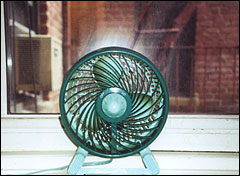Dear Umbra,
I’m a girl trying to make it in a big, hot, airless city — New York, that is. We’re in the middle of a heat wave that will soon end, but the longer heat wave we call summer will continue, so I wonder: when the interior of my apartment is up to 93 degrees and I have no less than three fans oscillating, am I using more energy than I would if I purchased and used one energy-efficient air conditioner? What’s the best choice here?
Elizabeth Q.
New York, N.Y.
Dearest Elizabeth,
I was in New York during that heat wave. My resultant suggestion is to carry a pail of ice water around the house with you, putting your feet into the pail each time you sit down. And don’t visit the sea lions at the zoo, as you will be overcome with jealousy watching them swim about in their clear blue pool.
As far as your fans go, they probably consume less electricity than a very efficient window air conditioner, and they certainly consume less energy than an older model. It’s hard to be exact without examining your very own fans, which should be marked somewhere with the maximum watts used. The DOE thinks a typical fan might draw 55 to 250 watts, which is a huge range; various other sources put the number at 87, 115, 150, and 200. Let us say three fans pull 450 watts — and at most, using DOE’s highest number, 750 watts.
Figuring the wattage of a window air conditioner is a bit more complex, but it likely is up near 1,000 watts for a typical unit. The size of an AC unit is usually measured in British Thermal Units, and the conditioner itself might be 6,000 BTUs or 18,000 BTUs; no one seems to care about the watts. Instead we need to care about the Energy Efficiency Rating, which is the ratio of cooling capacity to wattage (that is, the BTU divided by the watts). If we know the EER and the BTU, we can do a little math to figure the wattage (I’m sampling Energy Star-qualified units here, so they’ll be low-watt). A unit with 8,050 BTU capacity and an EER of 10.8 draws 745 watts; one with the same EER but 10,000 BTUs draws 923 watts.
That’s too many numbers, but here’s the upshot: if the fans are keeping you cool enough, stay with the status quo, because they are either equal to or better than a high-efficiency room air conditioner. Air conditioners also may contain environmentally damaging refrigerants, and while these should not be difficult to contain and properly dispose, it still would be better to avoid using them.
If your current fans are not doing the job, consider installing (or asking your landlord to install) a ceiling fan, which uses even less power than a floor fan and can help the whole room feel cooler. Still not cool enough? If you need to purchase a window air conditioner, please size it correctly for your home and buy the most efficient unit you can afford. Energy Star lists qualified units, the Consortium for Energy Efficiency pushes “super-efficient” units, and the EERE gives installation and operation tips.
Either way, don’t forget that neither fans nor AC should be operating when you are not at home. Fans make us feel cooler by convecting hot air away from our bods. If our bods are not there, the fan’s energy is wasted. And though we may think leaving AC on all day is more energy-efficient than having it kick into action after we get home, it is not. I repeat: Leaving AC on all day is not energy-efficient. If you can’t stand coming home to a hot house, get a timer for the AC and set it for half an hour before homecoming.
To get the most out of your fans, position them to grab at any slightly cooler air and push it past your bod. If the air outdoors is only going to make life hotter, close all the windows and shades until temperatures fall, and work with the air already in the house. Best of luck this summer.
Glowingly,
Umbra


